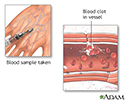Congenital platelet function defects
Platelet storage pool disorder; Glanzmann's thrombasthenia; Bernard-Soulier syndrome; Platelet function defects - congenital
Congenital platelet function defects are problems with one of the blood elements needed for clots to form normally. These cells are called platelets. Congenital means present from birth.
Causes
Congenital platelet function defects are bleeding disorders that cause reduced platelet function, even though there are normal platelet numbers.
Most of the time, people with these disorders have a family history of a bleeding disorder:
- Bernard-Soulier syndrome occurs when platelets lack a substance that sticks to the walls of blood vessels. This disorder may cause severe bleeding.
- Glanzmann thrombasthenia is a condition caused by the lack of a protein needed for platelets to clump together. This disorder may also cause severe bleeding.
- Platelet storage pool disorder (also called platelet secretion disorder) occurs when substances called granules inside platelets aren't stored or released properly. Granules help platelets function properly. This disorder causes easy bruising or bleeding.
Symptoms
Symptoms may include any of the following:
- Excessive bleeding during and after surgery
-
Bleeding gums
Bleeding gums
Bleeding gums can be a sign that you have or may develop gum disease. Ongoing gum bleeding may be due to plaque buildup on the teeth. It can also b...
Read Article Now Book Mark Article - Easy bruising
- Heavy menstrual periods
- Nosebleeds
- Prolonged bleeding with small injuries
Exams and Tests
The following tests may be used to diagnose this condition:
-
Bleeding time
Bleeding time
Bleeding time is a medical test that measures how fast small blood vessels in the skin stop bleeding.
 ImageRead Article Now Book Mark Article
ImageRead Article Now Book Mark Article -
Complete blood count (CBC)
Complete blood count (CBC)
A complete blood count (CBC) test measures the following:The number of red blood cells (RBC count)The number of white blood cells (WBC count)The tota...
 ImageRead Article Now Book Mark Article
ImageRead Article Now Book Mark Article -
Partial thromboplastin time (PTT)
Partial thromboplastin time (PTT)
Partial thromboplastin time (PTT) is a blood test that looks at how long it takes for blood to clot. It can help tell if you have a bleeding problem...
Read Article Now Book Mark Article -
Platelet aggregation test
Platelet aggregation test
The platelet aggregation blood test checks how well platelets, a part of blood, clump together and cause blood to clot.
Read Article Now Book Mark Article -
Prothrombin time (PT)
Prothrombin time (PT)
Prothrombin time (PT) is a blood test that measures the time it takes for the liquid portion (plasma) of your blood to clot. A related blood test is ...
Read Article Now Book Mark Article
You may need other tests. Your relatives may need to be tested.
Treatment
There is no specific treatment for these disorders. However, your health care provider will likely monitor your condition.
You may also need:
- To avoid taking aspirin and other nonsteroidal anti-inflammatory drugs (NSAIDs), such as ibuprofen and naproxen, because they can worsen bleeding symptoms.
- Platelet transfusions, such as during surgery or dental procedures.
Outlook (Prognosis)
There is no cure for congenital platelet function disorders. Most of the time, treatment can control the bleeding.
Possible Complications
Complications may include:
- Severe bleeding
-
Iron deficiency anemia
in menstruating women
Iron deficiency anemia
Anemia is a condition in which the body does not have enough healthy red blood cells. Red blood cells provide oxygen to body tissues. There are man...
 ImageRead Article Now Book Mark Article
ImageRead Article Now Book Mark Article
When to Contact a Medical Professional
Call your health care provider if:
- You have bleeding or bruising and do not know the cause.
- Bleeding does not respond to the usual method of control.
Prevention
A blood test can detect the gene responsible for the platelet defect. You may wish to seek genetic counseling if you have a family history of this problem and are considering having children.
References
Kottke-Marchant K. Platelet disorders. In: Hsi ED, ed. Hematopathology . 2nd ed. Philadelphia, PA: Elsevier Saunders; 2012:chap 2.
Nichols WL. Von Willebrand disease and hemorrhagic abnormalities of platelet and vascular function. In: Goldman L, Schafer AI, eds. Goldman-Cecil Medicine . 25th ed. Philadelphia, PA: Elsevier Saunders; 2016:chap 173.
-
Blood clot formation - illustration
Blood clotting normally occurs when there is damage to a blood vessel. Platelets immediately begin to adhere to the cut edges of the vessel and release chemicals to attract even more platelets. A platelet plug is formed, and the external bleeding stops. Next, small molecules, called clotting factors, cause strands of blood-borne materials, called fibrin, to stick together and seal the inside of the wound. Eventually, the cut blood vessel heals and the blood clot dissolves after a few days.
Blood clot formation
illustration
-
Blood clots - illustration
Blood clots (fibrin clots) are the clumps that result when blood coagulates.
Blood clots
illustration
-
Blood clot formation - illustration
Blood clotting normally occurs when there is damage to a blood vessel. Platelets immediately begin to adhere to the cut edges of the vessel and release chemicals to attract even more platelets. A platelet plug is formed, and the external bleeding stops. Next, small molecules, called clotting factors, cause strands of blood-borne materials, called fibrin, to stick together and seal the inside of the wound. Eventually, the cut blood vessel heals and the blood clot dissolves after a few days.
Blood clot formation
illustration
-
Blood clots - illustration
Blood clots (fibrin clots) are the clumps that result when blood coagulates.
Blood clots
illustration
-
Heart failure
(In-Depth)
-
Stroke
(In-Depth)
Review Date: 2/13/2015
Reviewed By: Rita Nanda, MD, Assistant Professor of Medicine, Section of Hematology/Oncology, University of Chicago Medicine, Chicago, IL. Review provided by VeriMed Healthcare Network. Also reviewed by David Zieve, MD, MHA, Isla Ogilvie, PhD, and the A.D.A.M. Editorial team.


